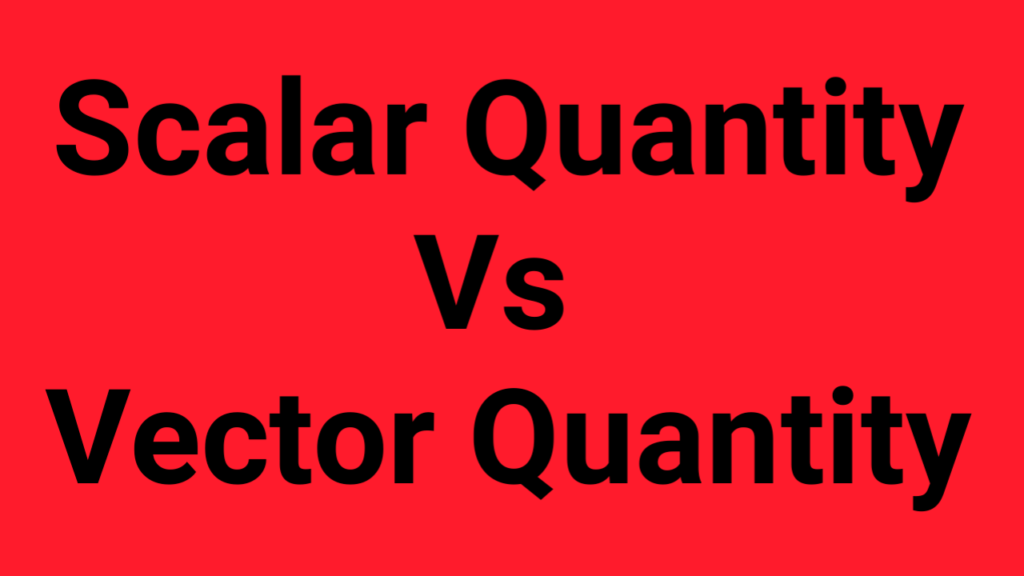What is the difference between scalar and vector quantity?
Scalar and vector are the two main classifications of the object. The quantity of an object can be described using magnitude and direction.
The main difference between vector and scalar quantity is that scalar quantity has only magnitude whereas vector quantity has both magnitude and direction.
Read More: Difference between Mass and Weight

Comparison Table (Scalar vs Vector Quantity)
| Basic Terms | Scalar Quantity | Vector Quantity |
| Meaning | It is a quantity that has the only magnitude | It is a quantity that has both magnitude and direction |
| Dimension | One dimensional | Has one, two, or three dimension |
| Change | It only indicates a change in the magnitude of the concerned physical quantity | It indicates the change in either magnitude or direction or both |
| Division of Quantity | Can be divided with another scalar quantity | Can never be divided |
| Mathematical Rules | Follow ordinary rules of algebra | Follow all rules of mathematical operation |
| Examples | Time, speed, mass, Area, Density, Work, etc | Displacement, Force, Velocity, Acceleration, Momentum, etc |
| Nature | Simple | Complex |
| Representation | Symbol of quantity | Either symbol of quantity in bold or direction of the arrow of the quantity |
What Is Scalar Quantity?
It is the measure of a quantity type described only by magnitude. Hence, variation in magnitude is what brings out the change is scalar quantities.
Scalar quantity operation follows all the basic rules of algebra. The magnitude of the object can be added, multiply, divided, and subtracted.
The dot product is a term used to describe the multiplication of scalar quantities. Main examples of scalar quantities are speed, time, etc,
What Is a Vector Quantity?
It is a type of quantity that is described by having both magnitude and direction. Two vector quantities are said to be equal when they have the same magnitude and direction.
Vector quantity does not follow all the basic rules of algebra. Keep in mind that vector quantities can never be divided.
Cross product is the multiplication of two vector quantities. The main examples of vector quantities are Displacement, Force, Velocity, Acceleration, Momentum, etc.
Main Difference between Scalar and Vector Quantity
- A scalar quantity has only magnitude whereas vector quantity has both magnitude and direction
- A scalar quantity has one dimension whereas a vector quantity has multiple directions
- The quantity of scalar change due to change is magnitude whereas that of vector change due to change magnitude and direction
- Scalar quantity follow basic rules of algebra while vector quantity follow different sets of rules
- One scalar quantity can divide one another whereas one vector quantity can never be divided
- Example of a scalar quantity is speed and time whereas examples of vector quantity are displacement, velocity, and force
Similarities between Scalar and Vector Quantity
- Both have units
- Both are physical quantities
- Both require dimensions
- Both discuss physical quantities
Scalar vs Vector Quantity FAQs
- What Is Scalar and Vector With Examples?
Scalar quantity examples are time and speed. On the other hand, vector quantity examples are force, velocity, and displacement
- Is Work Scalar Or Vector Quantity?
Scalar quantity. Work done due to displacement caused by a force is a scalar quantity. On the contrary, the dot product of vector quantity is always scalar
- What Is the Difference Between Scalar and Vector Product?
Scalar or dot product is used to describe the product of two vectors while vector product or cross product is used to the product of two vectors. If two vectors are perpendicular to each other than their scalar product is zero.
- Is Current Is A Vector Quantity?
Electric current is a scalar quantity. Any physical quantity is termed as a vector quantity when the quantity has magnitude and direction.
In the case of electric current, when two currents meet at a junction, the resultant current of these will be an algebraic sum and not the vector sum.
- Is Force Scalar Quantity?
No, force is a vector quantity. It has both magnitude and direction. Other examples of scalar quantities are displacement, velocity, acceleration, and force.
- Is Angular Momentum Is A Vector Quantity?
Angular velocity and angular momentum are vector quantities. Both have both direction and magnitude.
Comparison Video
Conclusion
Scalar quantities are those that display magnitude only whereas vector quantities are those that display both magnitude and direction.
Examples of scalar quantities are time, speed, work, distance, energy, power, temperature, volume, specific heat, density, entropy, gravitational potential, frequency, kinetic energy, etc
Examples of vector quantities are velocity, torque, momentum, magnetic field intensity, force, acceleration, etc
More Sources and References
- Vectors and Scalars. Physical Classroom
- Journal of Cosmology and Astroparticle Physics. IOP Science